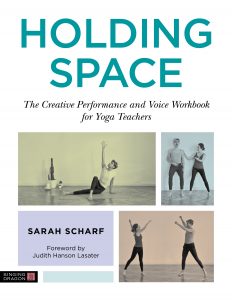 Sarah Scharf, MFA is a yoga teacher, author of the upcoming book, Holding Space: The Creative Performance and Voice Workbook for Yoga Teachers and theatre artist. She holds an MFA in Physical Theatre and has completed multiple training courses in Yoga of various styles. In London she taught at Triyoga – the largest studio in Europe – and worked as a mentor for the Yogacampus Teacher Training. She runs popular workshops and training on voice work and performance skills for yoga teachers, and works as a movement director and teaching artist for theatre. She is an American currently living in Vienna.
Sarah Scharf, MFA is a yoga teacher, author of the upcoming book, Holding Space: The Creative Performance and Voice Workbook for Yoga Teachers and theatre artist. She holds an MFA in Physical Theatre and has completed multiple training courses in Yoga of various styles. In London she taught at Triyoga – the largest studio in Europe – and worked as a mentor for the Yogacampus Teacher Training. She runs popular workshops and training on voice work and performance skills for yoga teachers, and works as a movement director and teaching artist for theatre. She is an American currently living in Vienna.
With the onset of regulations that have temporarily closed yoga studios and suspended public gatherings we have seen a rapid change in the yoga industry. Using live streaming video conferencing has become the most common way of teaching. Many of us have been challenged as teachers not only to learn to use the technology, but also to deal with the emotional elements of growing again as teachers. Some feel like they have to start over, especially those that relied heavily on hands on adjustments during their teaching and didn’t develop the language skills to adequately describe detailed movement or actions. This process of shifting online has shown many of us where we need to grow. It’s an opportunity for us to refine our work, to get more comfortable with ourselves and perhaps even create new opportunities.
There are many ways to teach online. I’ll focus on these options in the context of teaching yoga or movement and meditation:
- interactive livestream classes
- non-interactive livestream classes
- online trainings/workshops/courses
Interactive Live stream
Interactive live stream requires conferencing software if you want to control the entry of participants. The main bonus is that you can see your students in real time. This gives you the opportunity to offer verbal adjustments and individualised instruction. This is only possible when you can see your students, which will require a larger screen for bigger groups so you can avoid scrolling. Some teachers use a projector, making sure it is a quiet one so the sound isn’t a problem. Other teachers avoid demonstrating and simply sit close enough to their screen that they can see everyone. Continue reading